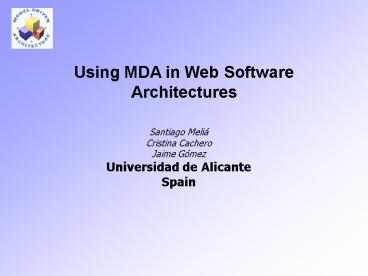Using MDA in Web Software Architectures - PowerPoint PPT Presentation
Title:
Using MDA in Web Software Architectures
Description:
Santiago Meli . Cristina Cachero. Jaime G mez. Universidad de Alicante. Spain ... Santiago Meli , Cristina Cachero & Jaime Gomez. OOPSLA'03/10 ... – PowerPoint PPT presentation
Number of Views:57
Avg rating:3.0/5.0
Title: Using MDA in Web Software Architectures
1
Using MDA in Web Software Architectures
Santiago Meliá Cristina Cachero Jaime
Gómez Universidad de Alicante Spain
2
Content
- Introduction
- Motivation
- Work Context Goals.
- WebSA Web Software Architecture.
- WebSA expressed with MDA. The view Model.
- Logical Architecture View in MDA.
- Generation strategy.
- Extension of the Architecture for MDA Models.
- Conclusions Future Work
3
1. Introduction
- The new challenges posed by Internet Market
imply - Development of more sophisticated Web
Applications in a shorter period of time. - Higher quality level to satisfy more demanding
clients. - The possibility to cover a vast diversity of web
applications with different non functional
requirements like number of clients, security,
maintenance,etc.
4
1. Introduction
- Work context
- Up to now, Web methodologies (OO-H Cachero03,
UWEKoch03, OOHDM, Schwabe99,etc) have paid
little attention to non functional requirements
for web applications. - Web generation techniques are only used to obtain
code for a predefined architecture of web
applications. - Objectives
- Integrate software architecture into Web
Applications in order to cover the gap between
web design and non functional requirements. - Have the ability to generate code able to cover
the vast diversity of web applications.
5
2. Web Software Architecture
- A new proposal called WebSA (Web Software
Architecture) which is based on two main aspects - The definition of specific software architecture
models for Web (DSSA) to complement other UML
proposals in the specification of Web
Applications. - The use of the MDA standard OMG 2001 to
formalize and describe such models.
6
3. WebSA expressed with MDA
- OMG2001 MDA defines an architecture for models
and provides a set of guidelines for structuring
specifications expressed as models. - It defines concepts as View, Refinement,
Abstract. - WebSA splits the web software architecture
description in several concurrent views as other
authors do with UML Krunchen95 Hofmeister et
all. 1999. - WebSA does this using also MDA and focusing on
the web domain, which allows for a higher level
of details in the specification process.
7
3.1 The WebSA view model
- This view model represents briefly the reference
model of WebSA.
8
3.2 Logical architecture view in MDA
- The Logical Architecture defines the set of
logical components (subsystems, modules and/or
software components) and the relationships
between them. - The WebSA logical architecture is subdivided in
three models - Subsystem Model determines which are the
subsystems that make up our application and the
best distribution in layers of our system. - Web Component Configuration Model provides an
ontology of web abstract components and
connectors that are particular to the web domain.
- Web Component Integration Model connects the
functional and the architectural views under a
common set of concrete components, modules and
connectors.
9
3.2 Logical architecture view in MDA
- The three architectural models are Independent
from the Platform. - Integration Model is defined at a level of
abstraction similar to that of the EDOC
profileOMG 2002. - WebSA is capable of automatically providing
different mappings platforms such as EJB, CORBA
or .NET.
10
3.2 Logical architecture view in MDA
- Possibility to classify the Web Integration Model
as PIMs in the context of MDA. - Integration Model is defined at a level of
abstraction similar to that of the EDOC
profileOMG 2002.
11
3.3. WebSA Generation Strategy
XML Interface
J2EE
.NET
CORBA...
Standard PSM
12
4. The Problem with Traditional MDA
- MDA, OMG 2001 when referring to quality
attributes says it is desirable to support and
integrate such features in the modeled
applications. Such integration can only be
achieved, as stated in Bass et al. 2000, by
specifying the software architecture system. - The subsystem model and the web component
configuration model cannot be integrated in the
traditional views of MDA because they are
independent from the problem domain, and are
exclusively influenced by the non functional
requirements or quality attributes.
13
4. Extension of the architecture for MDA Models
- Extended architecture provides
- A more rigorous mapping between the analysis
phase and the design phase. - A better quality of the generated code, because
it allows the definition of a generation
mechanism where both the functional and the
architectural parts are combined
14
Conclusions Future Works
- Conclusions
- We have presented a new proposal called WebSA for
the development of web applications. - Its aim is to extend the traditional MDA so as to
capture the non functional requirements. - We have proposed a code generation approach for
mapping a WebSA specification to an
implementation. - Future Works
- We are in the process of defining the UML profile
of WebSA. - We are going to extend the VisualWADE CASE Tool
to support this approach. - We intend to generate an XML specification to
feed template-code generators.
15
Thanks for your attention!!
Questions?































